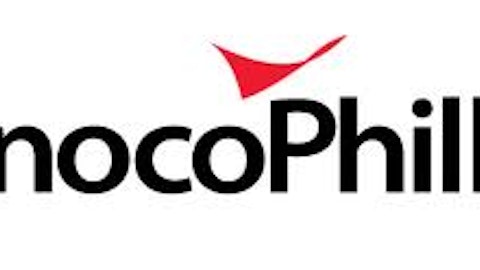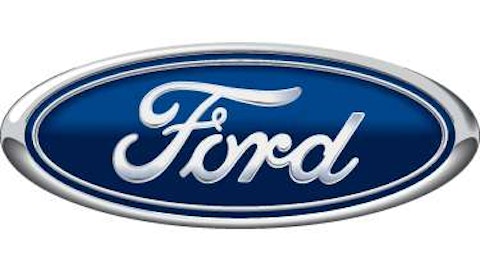ConocoPhillips (NYSE:COP) has reported fourth-quarter earnings for 2012, and this offers another opportunity to take a closer look at the company after it separated its downstream operations from its upstream ones. The company spun off its downstream business on April 2012 as Phillips 66, and the latest quarterly results provide a detailed insight into the exploration and production business as it currently stands.

Following recently concluded agreements to sell the company’s interests in the Kashagan Field, Algeria and Nigeria business units, the earnings and production impacts for these assets have been shown as discontinued operations, and the decreased adjusted earnings for fourth quarter 2012 amounted to $27 million, or $0.02 per share.
For the full year 2012, earnings were $8.4 billion, or $6.72 per share, compared to 2011 earnings of $12.4 billion, or $8.97 per share. Reported earnings for 2012 and 2011 included four months and 12 months of downstream results, and adjusted earnings were $6.7 billion, or $5.37 per share, compared with full-year 2011 adjusted earnings of $8.0 billion, or $5.75 per share.
Reserves and Operations
Preliminary year-end 2012 proved reserves amounted to 8.6 billion barrels of oil equivalent (BOE). Proved organic reserve additions for 2012 are projected to be 942 million BOE, which is an organic reserve replacement ratio of 156% of the production for the year including fuel gas. Sales for 2012, net of purchases, diminished reserves by 83 million BOE working out to a total reserve replacement ratio of 142%. Organic reserves were added across the portfolio including Canada, the Lower 48, Asia-Pacific and Europe.
Fourth-quarter production was 475,000 barrels of oil equivalent per day (MBOED) in the Lower 48 and Latin America an increase of 31 MBOED compared to the corresponding period of 2011. Significant growth continues to be generated from the ramp up of core shale plays in the Eagle Ford and Bakken, which produced approximately 113 MBOED, a 71% growth over the fourth quarter of 2011.
During the quarter, Eagle Ford averaged 89 MBOED, achieving a peak daily rate of more than 100 MBOED, while Bakken averaged 24 MBOED. Quarterly production in Canada increased by 17 MBOED over the same quarter in 2011, to 281 MBOED.
The company’s oil sands assets continue to show strong performance, with average production exceeding 100 MBOED for the quarter. The production mix in the Lower 48 and Canada continues to shift from natural gas to liquids and, for the quarter, total liquids production increased by 21% compared to the same period in 2011 and resulted in the liquids percentage of production increasing from 43% to 48%.
The company expects to increase its acreage in deepwater Gulf of Mexico by roughly 375,000 acres to 1.9 million acres as a result of successful participation in two lease sales in the central and western zones.
Price Realization and Cash Generation
Adjusted earnings decreased in comparison to fourth-quarter 2011 primarily because of lower commodity prices. The company’s total realized price fell to $67.45 per BOE, compared to $69.99 per BOE in the same quarter of the previous year. Realized crude oil prices decreased to $103.08 per barrel, compared with $105.92 per barrel, and realized natural gas liquids (NGL) prices fell by 18% to $44.93 per barrel in comparison to $55.06 per barrel for the same quarter of the previous year.
Realized natural gas prices fell to $5.79 per thousand cubic feet (MCF), compared with $5.88 per MCF for the fourth quarter of 2011. For the quarter, cash generated from continuing operations was $3.87 billion and, excluding a working capital increase of $0.37 billion, the company generated $4.24 billion in cash from operations. This was used to fund a $3.6 billion capital program and dividend payments of $0.8 billion. In addition, to $2.1 billion from asset dispositions in 2012, the company has announced asset sales that are expected to close by mid-2013 and generate proceeds of approximately $9.6 billion.
Other Energy Stocks
Refiners, including Phillips 66 and Marathon Petroleum Corp (NYSE:MPC) touched record highs as they beat consensus earnings estimates and have the potential to turn a plentiful supply of cheap U.S. oil into value addition for shareholders. Phillips 66, the largest U.S. independent refiner by revenue, plans to expand its share buyback program by $1 billion and raise its annual dividend. Excluding a refinery write-down, EPS at Phillips 66 was $2.06, which is 37 cents more than the $1.69 consensus estimate. Marathon Petroleum touched its highest price since June 2011 and said in a statement that it will expand its buyback program by $2 billion. Marathon Petroleum, spun off from Marathon Oil Corporation (NYSE:MRO) last year, reported fourth-quarter profit of $755 million, or $2.24 a share, 16 cents more than the $2.08 consensus estimate.
Conclusion
I believe that it will take some more time after the separation of Phillips 66 to properly analyze this company and establish its future prospects. Meanwhile, I think that the current price provides a fair valuation, and I rate the stock a “Hold.”
The article Is This Oil & Gas Major Fairly Valued? originally appeared on Fool.com and is written by Jordo Bivona.
Copyright © 1995 – 2013 The Motley Fool, LLC. All rights reserved. The Motley Fool has a disclosure policy.





